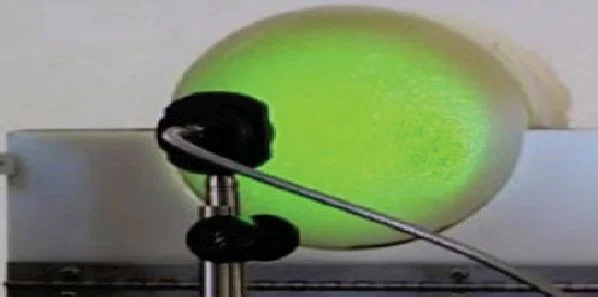Spanish scientists have developed a new type of laser technology based on photoacoustics that can be used for detecting breast cancer. The new technique is safe as no ionising radiation is used, and could become an alternative to commonly used diagnostic methods such as mammography and ultrasound, according to researchers from the Universidad Carlos III de Madrid (UC3M; Spain).
The technology uses the property of ultrasonic wave generation in tissue when it is illuminated with short, high-energy pulses of light. These signals make it possible to detect concentrations of chromophores (i.e., oxygenated haemoglobin, deoxygenated haemoglobin, and lipids) and to map tissue to find angiogenesis, a process which occurs in the malignant transformation of tumour growth, the researchers explained.
The European science project, coordinated by UC3M, is one area of research of Optical Imaging and Laser Techniques for Biomedical Applications (OILTEBIA), which recently held its first “European Summer School” on laser techniques and optical imaging for biomedical applications at the UC3M's Leganés campus. OILTEBIA is an Initial Training Network (ITN) funded by the European Community's Seventh Framework Programme.
During the sessions of the European Summer School, the UC3M researchers held a workshop on how to obtain photoacoustic images with the laser optoacoustic imaging system, available in their laboratory in addition to a breast tissue simulator.
“At present, several biomedical imaging techniques based on laser technologies are being researched, and every year new advances are made,” said OILTEBIA coordinator Horacio Lamela, head of the optoelectronics and laser technology group at the UC3M. Aside from the photoacoustics used for breast cancer detection, there are techniques such as diffuse optical tomography which are used to examine the functioning and afflictions of the brain and other organs through noninvasive means. This emerging field of scientific research has the potential to change the way medicine is viewed within a few years, according to some of the experts gathered at the summer school.
The OILTEBIA research project also aims to make advances with regard to hardware, including the design of pulsed sources for high-energy laser diodes and laser characterisation to generate photoacoustic waves. “As some of the partners in the project are large companies, it is possible the researchers will present designs for some very interesting and innovative devices,” Dr. Lamela said. For example, ongoing work on signal processing might produce new advances such as three-dimensional (3D)-reconstruction algorithms and different types of image fusion, including optical spectroscopy and ultrasonic signal processing. “Using different wavelengths allows us not only to map tissues but also detect certain substances and their concentrations,” Dr. Lamela explained.
OILTEBIA’s goal is to provide advanced training to researchers in novel biomedical optical imaging and laser techniques, whose applications include everything from basic research and discovery of medicines to new imaging for clinical diagnosis. These new medical imaging techniques are beginning to shift from the laboratory to the hospital.
The OILTEBIA consortium consists of 13 partners: four universities, three research laboratories and six industrial partners.
Source: MedImaging.net
Image Credit: Universidad Carlos III de Madrid
The technology uses the property of ultrasonic wave generation in tissue when it is illuminated with short, high-energy pulses of light. These signals make it possible to detect concentrations of chromophores (i.e., oxygenated haemoglobin, deoxygenated haemoglobin, and lipids) and to map tissue to find angiogenesis, a process which occurs in the malignant transformation of tumour growth, the researchers explained.
The European science project, coordinated by UC3M, is one area of research of Optical Imaging and Laser Techniques for Biomedical Applications (OILTEBIA), which recently held its first “European Summer School” on laser techniques and optical imaging for biomedical applications at the UC3M's Leganés campus. OILTEBIA is an Initial Training Network (ITN) funded by the European Community's Seventh Framework Programme.
During the sessions of the European Summer School, the UC3M researchers held a workshop on how to obtain photoacoustic images with the laser optoacoustic imaging system, available in their laboratory in addition to a breast tissue simulator.
“At present, several biomedical imaging techniques based on laser technologies are being researched, and every year new advances are made,” said OILTEBIA coordinator Horacio Lamela, head of the optoelectronics and laser technology group at the UC3M. Aside from the photoacoustics used for breast cancer detection, there are techniques such as diffuse optical tomography which are used to examine the functioning and afflictions of the brain and other organs through noninvasive means. This emerging field of scientific research has the potential to change the way medicine is viewed within a few years, according to some of the experts gathered at the summer school.
The OILTEBIA research project also aims to make advances with regard to hardware, including the design of pulsed sources for high-energy laser diodes and laser characterisation to generate photoacoustic waves. “As some of the partners in the project are large companies, it is possible the researchers will present designs for some very interesting and innovative devices,” Dr. Lamela said. For example, ongoing work on signal processing might produce new advances such as three-dimensional (3D)-reconstruction algorithms and different types of image fusion, including optical spectroscopy and ultrasonic signal processing. “Using different wavelengths allows us not only to map tissues but also detect certain substances and their concentrations,” Dr. Lamela explained.
OILTEBIA’s goal is to provide advanced training to researchers in novel biomedical optical imaging and laser techniques, whose applications include everything from basic research and discovery of medicines to new imaging for clinical diagnosis. These new medical imaging techniques are beginning to shift from the laboratory to the hospital.
The OILTEBIA consortium consists of 13 partners: four universities, three research laboratories and six industrial partners.
Source: MedImaging.net
Image Credit: Universidad Carlos III de Madrid
Latest Articles
breast cancer, medical imaging, ionising radiation, laser, photoacoustics
Spanish scientists have developed a new type of laser technology based on photoacoustics that can be used for detecting breast cancer. The new technique is...










